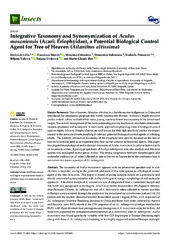Приказ основних података о документу
Integrative Taxonomy and Synonymization of Aculus mosoniensis (Acari: Eriophyidae), a Potential Biological Control Agent for Tree of Heaven (Ailanthus altissima)
| dc.creator | de Lillo, Enrico | |
| dc.creator | Marini, Francesca | |
| dc.creator | Cristofaro, Massimo | |
| dc.creator | Valenzano, Domenico | |
| dc.creator | Petanović, Radmila | |
| dc.creator | Vidović, Biljana | |
| dc.creator | Cvrković, Tatjana | |
| dc.creator | Bon, Marie-Claude | |
| dc.date.accessioned | 2023-07-14T10:48:03Z | |
| dc.date.available | 2023-07-14T10:48:03Z | |
| dc.date.issued | 2022 | |
| dc.identifier.issn | 2075-4450 | |
| dc.identifier.uri | https://plantarum.izbis.bg.ac.rs/handle/123456789/721 | |
| dc.description.abstract | The taxonomy of Aculus mosoniensis appears to be an unresolved question and its clarification is required, owing to the potential relevance of this mite species as a biological control agent of the tree of heaven. This paper is aimed at giving accurate details on a previously and shortly announced synonymization with Aculops taihangensis, using a morphological and molecular approach. A fusiform morph of A. mosoniensis was distinguished from a vermiform morph and this latter was recognized as deutogyne, which was herein documented. Phylogenetic relationships between Chinese Ac. taihangensis and all A. mosoniensis mites collected in twenty localities in Europe were examined through the analysis of the mitochondrial cytochrome c subunit I (CO1) protein and the nuclear ribosomal internal transcribed spacer 1 region (ITS1). CO1 sequences of Ac. taihangensis from the Shandong province in China and those from mites collected in Austria and Slovenia were 100% identical; the ITS1 sequence of an Ac. taihangensis paratype matched for 99.8% with those obtained from protogynes and deutogynes of A. mosoniensis collected in Italy. All these data supported the announced synonymization of A. mosoniensis with Ac. taihangensis. Aculus mosoniensis was found genetically variable, with five CO1 haplotypes in Europe (becoming eight along with those of Ac. taihangensis) clustering in two highly supported maternal lineages and eight ITS1 haplotypes (becoming nine along with those of Ac. taihangensis) distributed in four supported clades. No overlap between intra- and interspecies distances was observed for both markers and all studied A. mosoniensis populations clustered in one monophyletic mitochondrial clade, suggesting that only one single species might occur in Europe. However, more mite clades may be related to more tree of heaven biotypes with potential ecological differences, which might have potential effects on the biological control and should be investigated. | sr |
| dc.language.iso | en | sr |
| dc.publisher | MDPI Basel | sr |
| dc.relation | info:eu-repo/grantAgreement/MESTD/inst-2020/200116/RS// | sr |
| dc.relation | Serbian Academy of Sciences and Arts, Grant No. F-195 | sr |
| dc.rights | openAccess | sr |
| dc.rights.uri | https://creativecommons.org/licenses/by/4.0/ | |
| dc.source | Insects | sr |
| dc.subject | Aculops taihangensis | sr |
| dc.subject | deutogyne | sr |
| dc.subject | molecular analysis | sr |
| dc.subject | CO1 | sr |
| dc.subject | ITS1 | sr |
| dc.subject | invasive plant species | sr |
| dc.title | Integrative Taxonomy and Synonymization of Aculus mosoniensis (Acari: Eriophyidae), a Potential Biological Control Agent for Tree of Heaven (Ailanthus altissima) | sr |
| dc.type | article | sr |
| dc.rights.license | BY | sr |
| dc.citation.issue | 5 | |
| dc.citation.rank | M21 | |
| dc.citation.volume | 13 | |
| dc.type.version | publishedVersion | sr |
| dc.identifier.doi | 10.3390/insects13050489 | |
| dc.identifier.fulltext | http://plantarum.izbis.bg.ac.rs/bitstream/id/2900/bitstream_2900.pdf | |
| dc.identifier.scopus | 2-s2.0-85131131713 | |
| dc.identifier.wos | 00080315820000 |


